Hadoop分布式文件系统:架构和设计
Hadoop分布式文件系统(HDFS)详解
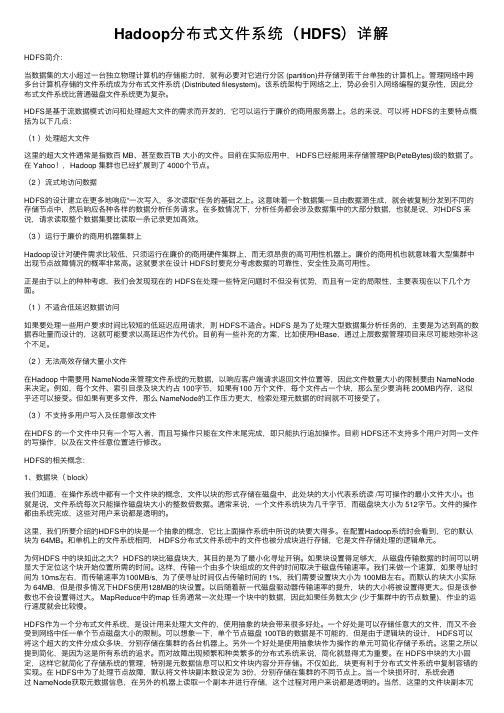
Hadoop分布式⽂件系统(HDFS)详解HDFS简介:当数据集的⼤⼩超过⼀台独⽴物理计算机的存储能⼒时,就有必要对它进⾏分区 (partition)并存储到若⼲台单独的计算机上。
管理⽹络中跨多台计算机存储的⽂件系统成为分布式⽂件系统 (Distributed filesystem)。
该系统架构于⽹络之上,势必会引⼊⽹络编程的复杂性,因此分布式⽂件系统⽐普通磁盘⽂件系统更为复杂。
HDFS是基于流数据模式访问和处理超⼤⽂件的需求⽽开发的,它可以运⾏于廉价的商⽤服务器上。
总的来说,可以将 HDFS的主要特点概括为以下⼏点:(1 )处理超⼤⽂件这⾥的超⼤⽂件通常是指数百 MB、甚⾄数百TB ⼤⼩的⽂件。
⽬前在实际应⽤中, HDFS已经能⽤来存储管理PB(PeteBytes)级的数据了。
在 Yahoo!,Hadoop 集群也已经扩展到了 4000个节点。
(2 )流式地访问数据HDFS的设计建⽴在更多地响应“⼀次写⼊,多次读取”任务的基础之上。
这意味着⼀个数据集⼀旦由数据源⽣成,就会被复制分发到不同的存储节点中,然后响应各种各样的数据分析任务请求。
在多数情况下,分析任务都会涉及数据集中的⼤部分数据,也就是说,对HDFS 来说,请求读取整个数据集要⽐读取⼀条记录更加⾼效。
(3 )运⾏于廉价的商⽤机器集群上Hadoop设计对硬件需求⽐较低,只须运⾏在廉价的商⽤硬件集群上,⽽⽆须昂贵的⾼可⽤性机器上。
廉价的商⽤机也就意味着⼤型集群中出现节点故障情况的概率⾮常⾼。
这就要求在设计 HDFS时要充分考虑数据的可靠性、安全性及⾼可⽤性。
正是由于以上的种种考虑,我们会发现现在的 HDFS在处理⼀些特定问题时不但没有优势,⽽且有⼀定的局限性,主要表现在以下⼏个⽅⾯。
(1 )不适合低延迟数据访问如果要处理⼀些⽤户要求时间⽐较短的低延迟应⽤请求,则 HDFS不适合。
HDFS 是为了处理⼤型数据集分析任务的,主要是为达到⾼的数据吞吐量⽽设计的,这就可能要求以⾼延迟作为代价。
HDFS原理和体系结构

HDFS原理和体系结构HDFS (Hadoop Distributed File System) 是 Hadoop 生态系统中的一部分,是一个分布式文件系统。
其设计目标是能够运行在廉价的硬件上,并能够容错和高效地处理大规模数据集。
HDFS 是 Hadoop 的核心组件之一,为 Hadoop 提供了存储和处理大规模数据的能力。
HDFS 的体系结构由以下几个组件组成:NameNode、DataNode、Secondary NameNode。
NameNode 是 HDFS 的关键组件之一,负责维护整个文件系统的文件和目录结构,以及每个文件的块的位置信息。
所有的文件操作都需要通过NameNode 进行验证和授权。
NameNode 还负责调度和协调任务的执行,如数据块的复制和恢复。
由于 NameNode 的重要性,它通常是单点故障,因此 HDFS 提供了一个 Secondary NameNode(即 CheckpointNode)来定期备份 NameNode 的数据,以防 NameNode 失效。
DataNode 是 HDFS 的另一个关键组件,负责实际存储数据。
每个DataNode 负责存储集群中一些数据块的副本。
当客户端请求读取文件时,DataNode 会返回所请求的数据块。
当客户端请求写入文件时,DataNode会接收数据块,并将其存储在本地磁盘上。
DataNode 还会周期性地向NameNode 报告其存储块的状态。
HDFS 采用了主从架构。
NameNode 作为主节点,负责管理集群的元数据和文件系统的命名空间。
而 DataNode 作为从节点,负责存储实际的数据。
这种分布式架构允许 HDFS 在集群中的多个节点上存储大规模数据,并且支持高容错性。
每个数据块都会在集群的不同节点上进行多次复制,以提供容错和高可用性。
HDFS的原理主要包括以下几个方面:1.数据切片与分布式存储:HDFS将文件切片成多个数据块,并将数据块分布在不同的节点上进行存储。
hadoop项目结构及各部分具体内容

hadoop项目结构及各部分具体内容Hadoop是一个开源的分布式计算框架,由Apache基金会管理。
它的核心是Hadoop分布式文件系统(HDFS)和MapReduce计算模型。
其项目结构包括以下几个部分:1. Hadoop Common:这是Hadoop项目的核心模块,包含文件系统、I/O操作、网络通信、安全性等基本功能的实现。
2. Hadoop HDFS:这是Hadoop的分布式文件系统,用于存储和管理大量数据。
它将数据分割成块,将这些块存储在不同的计算机上,以实现数据的可靠性和高可用性。
3. Hadoop YARN:这是Hadoop的资源管理器,用于管理集群中的资源,包括内存、CPU、磁盘等。
它可以将集群资源分配给运行在集群上的应用程序,从而提高资源利用率。
4. Hadoop MapReduce:这是Hadoop的计算模型,用于在分布式环境下执行大数据处理任务。
MapReduce将任务分成更小的子任务,然后在不同的计算机上并行执行这些子任务,最后将结果合并。
除了以上核心部分,Hadoop还包括一些其他功能模块:1. Hadoop Hive:这是一个基于Hadoop的数据仓库,提供了SQL 查询功能。
它可以将结构化数据映射到Hadoop HDFS上,从而实现大规模数据的查询和分析。
2. Hadoop Pig:这是一个基于Hadoop的数据流语言和平台,用于进行大规模数据处理和分析。
它支持多种数据源和处理方式,可以快速地进行数据的转换和操作。
3. Hadoop HBase:这是一个基于Hadoop的分布式数据库,用于存储大量的结构化数据。
它支持高可用性、可靠性和扩展性,并提供了快速查询和插入数据的功能。
总之,Hadoop是一个强大的大数据处理框架,它的各个部分提供了不同的功能和特性,可以轻松地处理大规模数据。
Hadoop分布式文件系统:架构和设计外文翻译
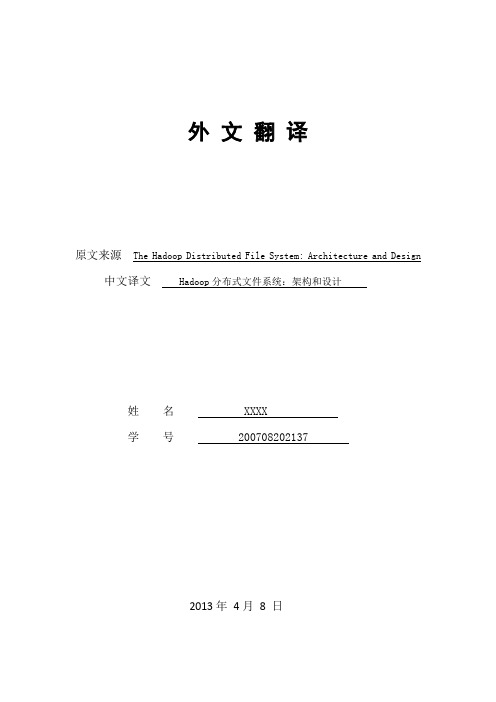
外文翻译原文来源The Hadoop Distributed File System: Architecture and Design 中文译文Hadoop分布式文件系统:架构和设计姓名 XXXX学号 ************2013年4月8 日英文原文The Hadoop Distributed File System: Architecture and DesignSource:/docs/r0.18.3/hdfs_design.html IntroductionThe Hadoop Distributed File System (HDFS) is a distributed file system designed to run on commodity hardware. It has many similarities with existing distributed file systems. However, the differences from other distributed file systems are significant. HDFS is highly fault-tolerant and is designed to be deployed onlow-cost hardware. HDFS provides high throughput access to application data and is suitable for applications that have large data sets. HDFS relaxes a few POSIX requirements to enable streaming access to file system data. HDFS was originally built as infrastructure for the Apache Nutch web search engine project. HDFS is part of the Apache Hadoop Core project. The project URL is/core/.Assumptions and GoalsHardware FailureHardware failure is the norm rather than the exception. An HDFS instance may consist of hundreds or thousands of server machines, each storing part of the file system’s data. The fact that there are a huge number of components and that each component has a non-trivial probability of failure means that some component of HDFS is always non-functional. Therefore, detection of faults and quick, automatic recovery from them is a core architectural goal of HDFS.Streaming Data AccessApplications that run on HDFS need streaming access to their data sets. They are not general purpose applications that typically run on general purpose file systems. HDFS is designed more for batch processing rather than interactive use by users. The emphasis is on high throughput of data access rather than low latency of data access. POSIX imposes many hard requirements that are notneeded for applications that are targeted for HDFS. POSIX semantics in a few key areas has been traded to increase data throughput rates.Large Data SetsApplications that run on HDFS have large data sets. A typical file in HDFS is gigabytes to terabytes in size. Thus, HDFS is tuned to support large files. It should provide high aggregate data bandwidth and scale to hundreds of nodes in a single cluster. It should support tens of millions of files in a single instance.Simple Coherency ModelHDFS applications need a write-once-read-many access model for files. A file once created, written, and closed need not be changed. This assumption simplifies data coherency issues and enables high throughput data access. AMap/Reduce application or a web crawler application fits perfectly with this model. There is a plan to support appending-writes to files in the future.“Moving Computation is Cheaper than Moving Data”A computation requested by an application is much more efficient if it is executed near the data it operates on. This is especially true when the size of the data set is huge. This minimizes network congestion and increases the overall throughput of the system. The assumption is that it is often better to migrate the computation closer to where the data is located rather than moving the data to where the application is running. HDFS provides interfaces for applications to move themselves closer to where the data is located.Portability Across Heterogeneous Hardware and Software PlatformsHDFS has been designed to be easily portable from one platform to another. This facilitates widespread adoption of HDFS as a platform of choice for a large set of applications.NameNode and DataNodesHDFS has a master/slave architecture. An HDFS cluster consists of a single NameNode, a master server that manages the file system namespace and regulates access to files by clients. In addition, there are a number of DataNodes, usually one per node in the cluster, which manage storage attached to the nodes that they run on. HDFS exposes a file system namespace and allows user data to be stored in files. Internally, a file is split into one or more blocks and these blocksare stored in a set of DataNodes. The NameNode executes file system namespace operations like opening, closing, and renaming files and directories. It also determines the mapping of blocks to DataNodes. The DataNodes are responsible for serving read and write requests from the file system’s clients. The DataNodes also perform block creation, deletion, and replication upon instruction from the NameNode.The NameNode and DataNode are pieces of software designed to run on commodity machines. These machines typically run a GNU/Linux operating system (OS). HDFS is built using the Java language; any machine that supports Java can run the NameNode or the DataNode software. Usage of the highly portable Java language means that HDFS can be deployed on a wide range ofmachines. A typical deployment has a dedicated machine that runs only the NameNode software. Each of the other machines in the cluster runs one instance of the DataNode software. The architecture does not preclude running multiple DataNodes on the same machine but in a real deployment that is rarely the case.The existence of a single NameNode in a cluster greatly simplifies the architecture of the system. The NameNode is the arbitrator and repository for all HDFS metadata. The system is designed in such a way that user data never flows through the NameNode.The File System NamespaceHDFS supports a traditional hierarchical file organization. A user or an application can create directories and store files inside these directories. The file system namespace hierarchy is similar to most other existing file systems; one can create and remove files, move a file from one directory to another, or rename a file. HDFS does not yet implement user quotas or access permissions. HDFS does not support hard links or soft links. However, the HDFS architecture does not preclude implementing these features.The NameNode maintains the file system namespace. Any change to the file system namespace or its properties is recorded by the NameNode. An application can specify the number of replicas of a file that should be maintained by HDFS. The number of copies of a file is called the replication factor of that file. This information is stored by the NameNode.Data ReplicationHDFS is designed to reliably store very large files across machines in a large cluster. It stores each file as a sequence of blocks; all blocks in a file except the last block are the same size. The blocks of a file are replicated for fault tolerance. The block size and replication factor are configurable per file. An application can specify the number of replicas of a file. The replication factor can be specified at file creation time and can be changed later. Files in HDFS are write-once and have strictly one writer at any time.The NameNode makes all decisions regarding replication of blocks. It periodically receives a Heartbeat and a Blockreport from each of the DataNodes in the cluster.Receipt of a Heartbeat implies that the DataNode is functioning properly. A Blockreport contains a list of all blocks on a DataNode.Replica Placement: The First Baby StepsThe placement of replicas is critical to HDFS reliability and performance. Optimizing replica placement distinguishes HDFS from most other distributed file systems. This is a feature that needs lots of tuning and experience. The purpose of a rack-aware replica placement policy is to improve data reliability, availability, and network bandwidth utilization. The current implementation for the replica placement policy is a first effort in this direction. The short-term goals of implementing this policy are to validate it on production systems, learn more about its behavior, and build a foundation to test and research more sophisticated policies.Large HDFS instances run on a cluster of computers that commonly spread across many racks. Communication between two nodes in different racks has to go through switches. In most cases, network bandwidth between machines in the same rack is greater than network bandwidth between machines in different racks.The NameNode determines the rack id each DataNode belongs to via the process outlined in Rack Awareness. A simple but non-optimal policy is to place replicas on unique racks. This prevents losing data when an entire rack fails and allows use of bandwidth from multiple racks when reading data. This policy evenly distributes replicas in the cluster which makes it easy to balance load on component failure. However, this policy increases the cost of writes because a write needs to transfer blocks to multiple racks.For the common case, when the replication factor is three, HDFS’s placement policy is to put one replica on one node in the local rack, another on a different node in the local rack, and the last on a different node in a different rack. This policy cuts the inter-rack write traffic which generally improves write performance. The chance of rack failure is far less than that of node failure; this policy does not impact data reliability and availability guarantees. However, it does reduce the aggregate network bandwidth used when reading data since a block is placed in only two unique racks rather than three. With this policy, the replicas of a file do not evenly distribute across the racks. One third of replicas are on one node, two thirds of replicas are on one rack, and the other third are evenly distributed across the remaining racks. This policy improves write performance without compromising data reliability or read performance.The current, default replica placement policy described here is a work in progress. Replica SelectionTo minimize global bandwidth consumption and read latency, HDFS tries to satisfy a read request from a replica that is closest to the reader. If there exists a replica on the same rack as the reader node, then that replica is preferred to satisfy the read request. If angg/ HDFS cluster spans multiple data centers, then a replica that is resident in the local data center is preferred over any remote replica.SafemodeOn startup, the NameNode enters a special state called Safemode. Replication of data blocks does not occur when the NameNode is in the Safemode state. The NameNode receives Heartbeat and Blockreport messages from the DataNodes. A Blockreport contains the list of data blocks that a DataNode is hosting. Each block has a specified minimum number of replicas. A block is considered safely replicated when the minimum number of replicas of that data block has checked in with the NameNode. After a configurable percentage of safely replicated data blocks checks in with the NameNode (plus an additional 30 seconds), the NameNode exits the Safemode state. It then determines the list of data blocks (if any) that still have fewer than the specified number of replicas. The NameNode then replicates these blocks to other DataNodes.The Persistence of File System MetadataThe HDFS namespace is stored by the NameNode. The NameNode uses a transaction log called the EditLog to persistently record every change that occurs to file system metadata. For example, creating a new file in HDFS causes the NameNode to insert a record into the EditLog indicating this. Similarly, changing the replication factor of a file causes a new record to be inserted into the EditLog. The NameNode uses a file in its local host OS file system to store the EditLog. The entire file system namespace, including the mapping of blocks to files and file system properties, is stored in a file called the FsImage. The FsImage is stored as a file in the NameNode’s local file system too.The NameNode keeps an image of the entire file system namespace and file Blockmap in memory. This key metadata item is designed to be compact, such that a NameNode with 4 GB of RAM is plenty to support a huge number of files and directories. When the NameNode starts up, it reads the FsImage and EditLog from disk, applies all the transactions from the EditLog to the in-memory representation of the FsImage, and flushes out this new version into a new FsImage on disk. It can then truncate the old EditLog because its transactions have been applied to the persistent FsImage. This process is called a checkpoint. In the current implementation, a checkpoint only occurs when the NameNode starts up. Work is in progress to support periodic checkpointing in the near future.The DataNode stores HDFS data in files in its local file system. The DataNode has no knowledge about HDFS files. It stores each block of HDFS data in a separatefile in its local file system. The DataNode does not create all files in the same directory. Instead, it uses a heuristic to determine the optimal number of files per directory and creates subdirectories appropriately. It is not optimal to create all local files in the same directory because the local file system might not be able to efficiently support a huge number of files in a single directory. When a DataNode starts up, it scans through its local file system, generates a list of all HDFS data blocks that correspond to each of these local files and sends this report to the NameNode: this is the Blockreport.The Communication ProtocolsAll HDFS communication protocols are layered on top of the TCP/IP protocol. A client establishes a connection to a configurable TCP port on the NameNode machine. It talks the ClientProtocol with the NameNode. The DataNodes talk to the NameNode using the DataNode Protocol. A Remote Procedure Call (RPC) abstraction wraps both the Client Protocol and the DataNode Protocol. By design, the NameNode never initiates any RPCs. Instead, it only responds to RPC requests issued by DataNodes or clients.RobustnessThe primary objective of HDFS is to store data reliably even in the presence of failures. The three common types of failures are NameNode failures, DataNode failures and network partitions.Data Disk Failure, Heartbeats and Re-ReplicationEach DataNode sends a Heartbeat message to the NameNode periodically. A network partition can cause a subset of DataNodes to lose connectivity with the NameNode. The NameNode detects this condition by the absence of a Heartbeat message. The NameNode marks DataNodes without recent Heartbeats as dead and does not forward any new IO requests to them. Any data that was registered to a dead DataNode is not available to HDFS any more. DataNode death may cause the replication factor of some blocks to fall below their specified value. The NameNode constantly tracks which blocks need to be replicated and initiates replication whenever necessary. The necessity for re-replication may arise due to many reasons: a DataNode may become unavailable, a replica may become corrupted, a hard disk on a DataNode may fail, or the replication factor of a file may be increased.Cluster RebalancingThe HDFS architecture is compatible with data rebalancing schemes. A scheme might automatically move data from one DataNode to another if the free space on a DataNode falls below a certain threshold. In the event of a sudden high demand for a particular file, a scheme might dynamically create additional replicas and rebalance other data in the cluster. These types of data rebalancing schemes are not yet implemented.Data IntegrityIt is possible that a block of data fetched from a DataNode arrives corrupted. This corruption can occur because of faults in a storage device, network faults, or buggy software. The HDFS client software implements checksum checking on the contents of HDFS files. When a client creates an HDFS file, it computes a checksum of each block of the file and stores these checksums in a separate hidden file in the same HDFS namespace. When a client retrieves file contents it verifies that the data it received from each DataNode matches the checksum stored in the associated checksum file. If not, then the client can opt to retrieve that block from another DataNode that has a replica of that block.Metadata Disk FailureThe FsImage and the EditLog are central data structures of HDFS. A corruption of these files can cause the HDFS instance to be non-functional. For this reason, the NameNode can be configured to support maintaining multiple copies of the FsImage and EditLog. Any update to either the FsImage or EditLog causes each of the FsImages and EditLogs to get updated synchronously. This synchronous updating of multiple copies of the FsImage and EditLog may degrade the rate of namespace transactions per second that a NameNode can support. However, this degradation is acceptable because even though HDFS applications are very data intensive in nature, they are not metadata intensive. When a NameNode restarts, it selects the latest consistent FsImage and EditLog to use.The NameNode machine is a single point of failure for an HDFS cluster. If the NameNode machine fails, manual intervention is necessary. Currently, automatic restart and failover of the NameNode software to another machine is not supported.SnapshotsSnapshots support storing a copy of data at a particular instant of time. One usage of the snapshot feature may be to roll back a corrupted HDFS instance to a previously known good point in time. HDFS does not currently support snapshots but will in a future release.Data OrganizationData BlocksHDFS is designed to support very large files. Applications that are compatible with HDFS are those that deal with large data sets. These applications write their data only once but they read it one or more times and require these reads to be satisfied at streaming speeds. HDFS supports write-once-read-many semantics on files. A typical block size used by HDFS is 64 MB. Thus, an HDFS file is chopped up into 64 MB chunks, and if possible, each chunk will reside on a different DataNode.StagingA client request to create a file does not reach the NameNode immediately. In fact, initially the HDFS client caches the file data into a temporary local file. Application writes are transparently redirected to this temporary local file. When the local file accumulates data worth over one HDFS block size, the client contacts the NameNode. The NameNode inserts the file name into the file system hierarchy and allocates a data block for it. The NameNode responds to the client request with the identity of the DataNode and the destination data block. Then the client flushes the block of data from the local temporary file to the specified DataNode. When a file is closed, the remaining un-flushed data in the temporary local file is transferred to the DataNode. The client then tells the NameNode that the file is closed. At this point, the NameNode commits the file creation operation into a persistent store. If the NameNode dies before the file is closed, the file is lost.The above approach has been adopted after careful consideration of target applications that run on HDFS. These applications need streaming writes to files. If a client writes to a remote file directly without any client side buffering, the network speed and the congestion in the network impacts throughput considerably. This approach is not without precedent. Earlier distributed file systems, e.g. AFS, have used client side caching to improve performance. APOSIX requirement has been relaxed to achieve higher performance of data uploads.Replication PipeliningWhen a client is writing data to an HDFS file, its data is first written to a local file as explained in the previous section. Suppose the HDFS file has a replication factor of three. When the local file accumulates a full block of user data, the client retrieves a list of DataNodes from the NameNode. This list contains the DataNodes that will host a replica of that block. The client then flushes the data block to the first DataNode. The first DataNode starts receiving the data in small portions (4 KB), writes each portion to its local repository and transfers that portion to the second DataNode in the list. The second DataNode, in turn starts receiving each portion of the data block, writes that portion to its repository and then flushes that portion to the third DataNode. Finally, the third DataNode writes the data to its local repository. Thus, a DataNode can be receiving data from the previous one in the pipeline and at the same time forwarding data to the next one in the pipeline. Thus, the data is pipelined from one DataNode to the next.AccessibilityHDFS can be accessed from applications in many different ways. Natively, HDFS provides a Java API for applications to use. A C language wrapper for this Java API is also available. In addition, an HTTP browser can also be used to browse the files of an HDFS instance. Work is in progress to expose HDFS through the WebDAV protocol.FS ShellHDFS allows user data to be organized in the form of files and directories. It provides a commandline interface called FS shell that lets a user interact with the data in HDFS. The syntax of this command set is similar to other shells (e.g. bash, csh) that users are already familiar with. Here are some sample action/command pairs:FS shell is targeted for applications that need a scripting language to interact with the stored data.DFSAdminThe DFSAdmin command set is used for administering an HDFS cluster. These are commands that are used only by an HDFS administrator. Here are some sample action/command pairs:Browser InterfaceA typical HDFS install configures a web server to expose the HDFS namespace through a configurable TCP port. This allows a user to navigate the HDFS namespace and view the contents of its files using a web browser.Space ReclamationFile Deletes and UndeletesWhen a file is deleted by a user or an application, it is not immediately removed from HDFS. Instead, HDFS first renames it to a file in the /trash directory. The file can be restored quickly as long as it remains in /trash. A file remains in/trash for a configurable amount of time. After the expiry of its life in /trash, the NameNode deletes the file from the HDFS namespace. The deletion of a file causes the blocks associated with the file to be freed. Note that there could be an appreciable time delay between the time a file is deleted by a user and the time of the corresponding increase in free space in HDFS.A user can Undelete a file after deleting it as long as it remains in the /trash directory. If a user wants to undelete a file that he/she has deleted, he/she can navigate the /trash directory and retrieve the file. The /trash directory contains only the latest copy of the file that was deleted. The /trash directory is just like any other directory with one special feature: HDFS applies specified policies to automatically delete files from this directory. The current default policy is to delete files from /trash that are more than 6 hours old. In the future, this policy will be configurable through a well defined interface.Decrease Replication FactorWhen the replication factor of a file is reduced, the NameNode selects excess replicas that can be deleted. The next Heartbeat transfers this information to the DataNode. The DataNode then removes the corresponding blocks and the corresponding free space appears in the cluster. Once again, there might be a time delay between the completion of the setReplication API call and the appearance of free space in the cluster.中文译本原文地址:/docs/r0.18.3/hdfs_design.html一、引言Hadoop分布式文件系统(HDFS)被设计成适合运行在通用硬件(commodity hardware)上的分布式文件系统。
hadoop 原理
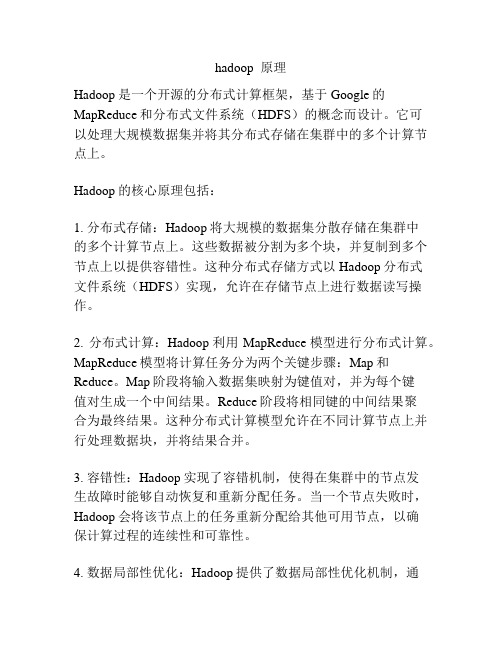
hadoop 原理Hadoop是一个开源的分布式计算框架,基于Google的MapReduce和分布式文件系统(HDFS)的概念而设计。
它可以处理大规模数据集并将其分布式存储在集群中的多个计算节点上。
Hadoop的核心原理包括:1. 分布式存储:Hadoop将大规模的数据集分散存储在集群中的多个计算节点上。
这些数据被分割为多个块,并复制到多个节点上以提供容错性。
这种分布式存储方式以Hadoop分布式文件系统(HDFS)实现,允许在存储节点上进行数据读写操作。
2. 分布式计算:Hadoop利用MapReduce模型进行分布式计算。
MapReduce模型将计算任务分为两个关键步骤:Map和Reduce。
Map阶段将输入数据集映射为键值对,并为每个键值对生成一个中间结果。
Reduce阶段将相同键的中间结果聚合为最终结果。
这种分布式计算模型允许在不同计算节点上并行处理数据块,并将结果合并。
3. 容错性:Hadoop实现了容错机制,使得在集群中的节点发生故障时能够自动恢复和重新分配任务。
当一个节点失败时,Hadoop会将该节点上的任务重新分配给其他可用节点,以确保计算过程的连续性和可靠性。
4. 数据局部性优化:Hadoop提供了数据局部性优化机制,通过将计算任务调度到存储有数据块的节点上来减少数据传输开销。
这样可以最大限度地利用集群内部的带宽和计算资源,提高计算效率。
5. 扩展性:Hadoop的分布式架构具有良好的可扩展性,允许根据需求增加或减少集群中的计算节点。
这种可扩展性使得Hadoop能够处理大规模数据集,并且可以处理节点故障或新节点的加入。
综上所述,Hadoop通过分布式存储和计算、容错性、数据局部性优化和可扩展性等主要原理,实现了对大规模数据集的高效处理和分析。
hadoop基本架构和工作原理
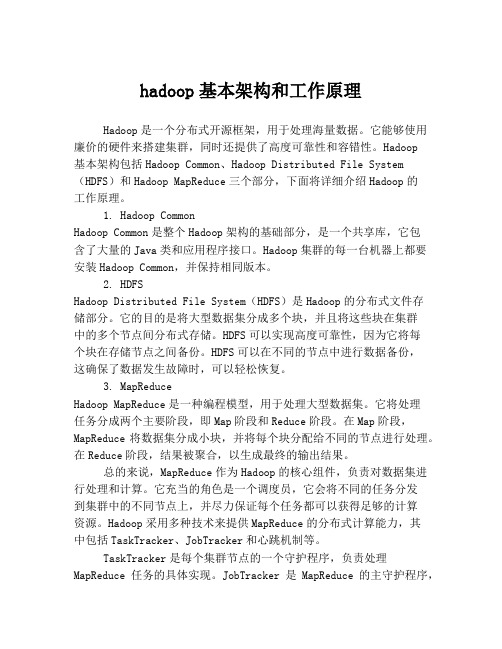
hadoop基本架构和工作原理Hadoop是一个分布式开源框架,用于处理海量数据。
它能够使用廉价的硬件来搭建集群,同时还提供了高度可靠性和容错性。
Hadoop基本架构包括Hadoop Common、Hadoop Distributed File System (HDFS)和Hadoop MapReduce三个部分,下面将详细介绍Hadoop的工作原理。
1. Hadoop CommonHadoop Common是整个Hadoop架构的基础部分,是一个共享库,它包含了大量的Java类和应用程序接口。
Hadoop集群的每一台机器上都要安装Hadoop Common,并保持相同版本。
2. HDFSHadoop Distributed File System(HDFS)是Hadoop的分布式文件存储部分。
它的目的是将大型数据集分成多个块,并且将这些块在集群中的多个节点间分布式存储。
HDFS可以实现高度可靠性,因为它将每个块在存储节点之间备份。
HDFS可以在不同的节点中进行数据备份,这确保了数据发生故障时,可以轻松恢复。
3. MapReduceHadoop MapReduce是一种编程模型,用于处理大型数据集。
它将处理任务分成两个主要阶段,即Map阶段和Reduce阶段。
在Map阶段,MapReduce将数据集分成小块,并将每个块分配给不同的节点进行处理。
在Reduce阶段,结果被聚合,以生成最终的输出结果。
总的来说,MapReduce作为Hadoop的核心组件,负责对数据集进行处理和计算。
它充当的角色是一个调度员,它会将不同的任务分发到集群中的不同节点上,并尽力保证每个任务都可以获得足够的计算资源。
Hadoop采用多种技术来提供MapReduce的分布式计算能力,其中包括TaskTracker、JobTracker和心跳机制等。
TaskTracker是每个集群节点的一个守护程序,负责处理MapReduce任务的具体实现。
hadoop的生态体系及各组件的用途

hadoop的生态体系及各组件的用途
Hadoop是一个生态体系,包括许多组件,以下是其核心组件和用途:
1. Hadoop Distributed File System (HDFS):这是Hadoop的分布式文件系统,用于存储大规模数据集。
它设计为高可靠性和高吞吐量,并能在低成本的通用硬件上运行。
通过流式数据访问,它提供高吞吐量应用程序数据访问功能,适合带有大型数据集的应用程序。
2. MapReduce:这是Hadoop的分布式计算框架,用于并行处理和分析大规模数据集。
MapReduce模型将数据处理任务分解为Map和Reduce两个阶段,从而在大量计算机组成的分布式并行环境中有效地处理数据。
3. YARN:这是Hadoop的资源管理和作业调度系统。
它负责管理集群资源、调度任务和监控应用程序。
4. Hive:这是一个基于Hadoop的数据仓库工具,提供SQL-like查询语言和数据仓库功能。
5. Kafka:这是一个高吞吐量的分布式消息队列系统,用于实时数据流的收集和传输。
6. Pig:这是一个用于大规模数据集的数据分析平台,提供类似SQL的查询语言和数据转换功能。
7. Ambari:这是一个Hadoop集群管理和监控工具,提供可视化界面和集群配置管理。
此外,HBase是一个分布式列存数据库,可以与Hadoop配合使用。
HBase 中保存的数据可以使用MapReduce来处理,它将数据存储和并行计算完美地结合在一起。
分布式存储系统及解决方案介绍
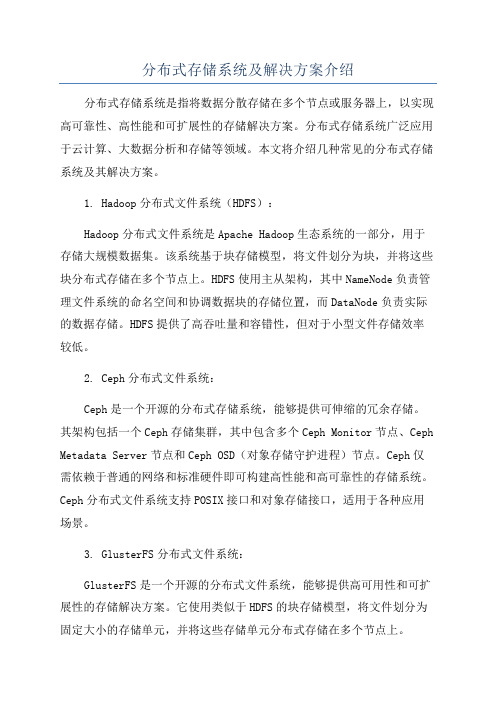
分布式存储系统及解决方案介绍分布式存储系统是指将数据分散存储在多个节点或服务器上,以实现高可靠性、高性能和可扩展性的存储解决方案。
分布式存储系统广泛应用于云计算、大数据分析和存储等领域。
本文将介绍几种常见的分布式存储系统及其解决方案。
1. Hadoop分布式文件系统(HDFS):Hadoop分布式文件系统是Apache Hadoop生态系统的一部分,用于存储大规模数据集。
该系统基于块存储模型,将文件划分为块,并将这些块分布式存储在多个节点上。
HDFS使用主从架构,其中NameNode负责管理文件系统的命名空间和协调数据块的存储位置,而DataNode负责实际的数据存储。
HDFS提供了高吞吐量和容错性,但对于小型文件存储效率较低。
2. Ceph分布式文件系统:Ceph是一个开源的分布式存储系统,能够提供可伸缩的冗余存储。
其架构包括一个Ceph存储集群,其中包含多个Ceph Monitor节点、Ceph Metadata Server节点和Ceph OSD(对象存储守护进程)节点。
Ceph仅需依赖于普通的网络和标准硬件即可构建高性能和高可靠性的存储系统。
Ceph分布式文件系统支持POSIX接口和对象存储接口,适用于各种应用场景。
3. GlusterFS分布式文件系统:GlusterFS是一个开源的分布式文件系统,能够提供高可用性和可扩展性的存储解决方案。
它使用类似于HDFS的块存储模型,将文件划分为固定大小的存储单元,并将这些存储单元分布式存储在多个节点上。
GlusterFS采用主从架构,其中GlusterFS Server节点负责存储数据和文件系统元数据,而GlusterFS Client节点提供文件系统访问接口。
GlusterFS具有良好的可伸缩性和容错性,并可以支持海量数据存储。
4. Amazon S3分布式存储系统:Amazon S3(Simple Storage Service)是亚马逊云服务提供的分布式对象存储系统。
HDFS的工作原理

HDFS的工作原理HDFS(Hadoop Distributed File System)是Hadoop生态系统中的一个分布式文件系统,被广泛应用于大数据处理和存储。
它的设计目标是在便宜的硬件上存储大规模数据,并提供高容错性、高吞吐量的数据访问。
HDFS的工作原理可以简单概括为以下几个方面:文件切块、分布式存储、容错机制和数据访问。
1. 文件切块:HDFS将要存储的文件切分成固定大小的块(默认大小为128MB),每一个块都会被复制多个副本存储在集群中的不同节点上。
文件切块的目的是为了方便并行处理和数据的分布式存储。
2. 分布式存储:HDFS将切分的文件块分散存储在集群中的不同节点上,这些节点被称为DataNode。
每一个DataNode负责存储和管理一部份文件块的副本。
这种分布式存储方式可以提高数据的可靠性和可扩展性。
3. 容错机制:HDFS通过复制机制提供容错性。
每一个文件块的副本会被存储在不同的DataNode上,通常默认情况下会存储3个副本。
这样即使某个节点发生故障,其他节点上的副本仍然可以提供数据访问。
当某个副本损坏或者丢失时,HDFS会自动从其他副本中恢复数据。
4. 数据访问:HDFS采用了主从架构,其中有一个NameNode和多个DataNode。
NameNode 负责管理文件系统的元数据,包括文件的目录结构、文件和块的映射关系等。
DataNode负责存储实际的数据块。
当用户需要读取或者写入文件时,首先会向NameNode发送请求,NameNode 会返回相应的文件块的位置信息,然后用户直接与DataNode进行数据的读取或者写入操作。
由于数据块在集群中的分布式存储,可以并行读取多个数据块,从而提高了数据的访问速度。
总结起来,HDFS的工作原理包括文件切块、分布式存储、容错机制和数据访问。
通过这些机制,HDFS实现了大规模数据的高效存储和处理。
它的设计目标是为了满足大数据处理的需求,提供高可靠性、高可扩展性和高吞吐量的数据访问。
hadoop毕业设计总结

hadoop毕业设计总结Hadoop是一个开源的分布式计算框架,广泛应用于大数据处理和分析。
在我的毕业设计中,我选择了使用Hadoop作为主要的技术工具,完成了一个基于Hadoop的大数据分析系统。
首先,在我的毕业设计中,我深入学习了Hadoop的架构和工作原理。
Hadoop由两个核心组件组成:Hadoop分布式文件系统(HDFS)和Hadoop分布式计算框架(MapReduce)。
HDFS提供了分布式存储服务,将大量的数据块分散存储在多个服务器上,实现数据的高可靠性和高吞吐量。
MapReduce是Hadoop的计算模型,能够将计算任务分解为多个子任务,并进行分布式并行计算。
其次,我了解了Hadoop的生态系统,包括Hive、Pig、HBase等工具和组件。
这些工具和组件可以与Hadoop无缝集成,提供更高级别的数据处理和分析功能。
在我的毕业设计中,我利用Hive进行了数据存储和查询,通过Pig进行了数据清洗和转换,并使用HBase进行了数据的实时查询和分析。
最后,我设计并实现了一个大数据分析系统,在实验室的服务器上搭建了一个多节点的Hadoop集群,并使用该系统对大规模的数据进行了处理和分析。
通过我的设计,可以快速、高效地处理和分析大量的数据,并生成有关数据的报告和可视化结果。
在毕业设计的过程中,我遇到了很多挑战和困难。
首先是Hadoop集群的搭建和配置。
由于Hadoop需要多个节点来实现分布式计算,我需要配置和管理多个服务器,保证它们的正常工作和通信。
其次是数据的处理和分析。
大规模的数据需要经过预处理、清洗和转换之后才能进行进一步的分析,我需要编写MapReduce程序和使用Hive和Pig等工具来完成这些任务。
通过这个毕业设计,我深入了解了Hadoop和大数据分析的原理和应用,提高了实际操作和编程的能力。
我还学会了团队合作和解决问题的能力,在与同学和指导教师的合作中,共同解决了技术难题和系统故障。
HDFS的架构及原理
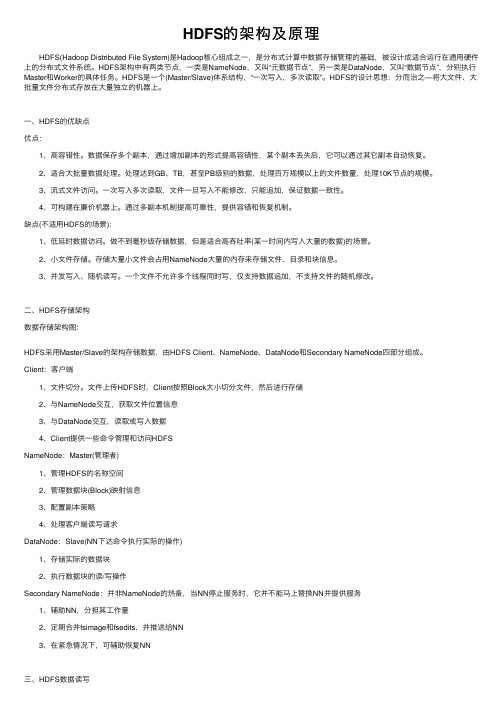
HDFS的架构及原理 HDFS(Hadoop Distributed File System)是Hadoop核⼼组成之⼀,是分布式计算中数据存储管理的基础,被设计成适合运⾏在通⽤硬件上的分布式⽂件系统。
HDFS架构中有两类节点,⼀类是NameNode,⼜叫“元数据节点”,另⼀类是DataNode,⼜叫“数据节点”,分别执⾏Master和Worker的具体任务。
HDFS是⼀个(Master/Slave)体系结构,“⼀次写⼊,多次读取”。
HDFS的设计思想:分⽽治之—将⼤⽂件、⼤批量⽂件分布式存放在⼤量独⽴的机器上。
⼀、HDFS的优缺点优点: 1、⾼容错性。
数据保存多个副本,通过增加副本的形式提⾼容错性,某个副本丢失后,它可以通过其它副本⾃动恢复。
2、适合⼤批量数据处理。
处理达到GB、TB,甚⾄PB级别的数据,处理百万规模以上的⽂件数量,处理10K节点的规模。
3、流式⽂件访问。
⼀次写⼊多次读取,⽂件⼀旦写⼊不能修改,只能追加,保证数据⼀致性。
4、可构建在廉价机器上。
通过多副本机制提⾼可靠性,提供容错和恢复机制。
缺点(不适⽤HDFS的场景): 1、低延时数据访问。
做不到毫秒级存储数据,但是适合⾼吞吐率(某⼀时间内写⼊⼤量的数据)的场景。
2、⼩⽂件存储。
存储⼤量⼩⽂件会占⽤NameNode⼤量的内存来存储⽂件、⽬录和块信息。
3、并发写⼊、随机读写。
⼀个⽂件不允许多个线程同时写,仅⽀持数据追加,不⽀持⽂件的随机修改。
⼆、HDFS存储架构数据存储架构图:HDFS采⽤Master/Slave的架构存储数据,由HDFS Client、NameNode、DataNode和Secondary NameNode四部分组成。
Client:客户端 1、⽂件切分。
⽂件上传HDFS时,Client按照Block⼤⼩切分⽂件,然后进⾏存储 2、与NameNode交互,获取⽂件位置信息 3、与DataNode交互,读取或写⼊数据 4、Client提供⼀些命令管理和访问HDFSNameNode:Master(管理者) 1、管理HDFS的名称空间 2、管理数据块(Block)映射信息 3、配置副本策略 4、处理客户端读写请求DataNode:Slave(NN下达命令执⾏实际的操作) 1、存储实际的数据块 2、执⾏数据块的读/写操作Secondary NameNode:并⾮NameNode的热备,当NN停⽌服务时,它并不能马上替换NN并提供服务 1、辅助NN,分担其⼯作量 2、定期合并fsimage和fsedits,并推送给NN 3、在紧急情况下,可辅助恢复NN三、HDFS数据读写⽂件读取步骤: 1、⾸先调⽤FileSystem的open⽅法获取⼀个DistributedFileSystem实例。
ApacheHadoop框架详细分析

ApacheHadoop框架详细分析Apache Hadoop框架详细分析Apache Hadoop框架是一种用于大规模数据处理的开源软件,它通过分布式存储和计算能力来解决大数据处理的问题。
本文将对Apache Hadoop框架进行详细分析,包括其核心组件、架构以及应用场景等。
一、Hadoop框架概述Apache Hadoop是一个能够处理大规模数据的分布式计算框架,它由Apache软件基金会下的Hadoop项目开发和维护。
Hadoop的设计目标是以廉价的硬件构建可靠的、可扩展的分布式系统,并且能够对大规模数据进行高效的分布式处理。
Hadoop主要包括两个核心组件:分布式文件系统Hadoop HDFS和分布式计算框架Hadoop MapReduce。
HDFS用于存储大量数据,并将其分布在集群的多个节点上,实现高容错性和高可靠性。
MapReduce是一种分布式计算模型,通过将任务分解为多个片段并在多个节点上并行执行,实现对大规模数据的并行处理。
二、Hadoop框架架构Hadoop框架的架构由主节点(Master)和多个从节点(Slave)组成,其中主节点包括一个名称节点(NameNode)和一个资源管理器(ResourceManager),从节点包括多个数据节点(DataNode)和节点管理器(NodeManager)。
名称节点负责管理文件系统的命名空间和数据块的位置信息,资源管理器负责协调集群中的资源分配和任务调度。
数据节点负责存储和管理数据块,节点管理器负责管理从节点上的计算资源和任务执行。
Hadoop框架的工作流程如下:首先,客户端将输入文件划分为多个数据块,并将这些数据块分布存储在HDFS中的不同数据节点上;然后,客户端向资源管理器提交MapReduce任务,资源管理器根据集群的资源情况进行任务调度,并将任务分配给可用的从节点;接下来,从节点通过数据节点读取数据块,并由节点管理器负责执行Map和Reduce任务;最后,任务输出结果写入HDFS,并由客户端读取和处理。
HDFS简介

HDFS简介作为Hadoop的核心技术之一,HDFS(Hadoop distributed File System,Hadoop分布式文件系统)是分布式计算中数据存储管理的基础。
它所具有的高容错高可靠性、高可扩展性、高获得性、高吞吐率等特征为海量数据提供了不怕故障的存储,为超大数据集(Large Data Set)的应用处理带来了很多便利。
HDFS放宽了一部分POSIX约束,来实现流式读取文件系统数据的目的。
HDFS在最开始是作为Apache Nutch搜索引擎项目的基础架构而开发的。
HDFS 是Apache Hadoop Core项目的一部分。
前提和设计目标硬件错误硬件错误是常态而不是异常。
HDFS可能由成百上千的服务器所构成,每个服务器上存储着文件系统的部分数据。
我们面对的现实是构成系统的组件数目是巨大的,而且任一组件都有可能失效,这意味着总是有一部分HDFS的组件是不工作的。
因此错误检测和快速、自动的恢复是HDFS最核心的架构目标。
流式数据访问HDFS的设计中更多的考虑到了数据批处理,而不是用户交互处理。
比之数据访问的低延迟问题,更关键的在于数据访问的高吞吐量。
POSIX标准设置的很多硬性约束对HDFS应用系统不是必需的。
为了提高数据的吞吐量,在一些关键方面对POSIX的语义做了一些修改。
大规模数据集HDFS上的一个典型文件大小一般都在G字节至T字节。
因此,HDFS被调节以支持大文件存储。
它应该能提供整体上高的数据传输带宽,能在一个集群里扩展到数百个节点。
一个单一的HDFS实例应该能支撑数以千万计的文件。
简单的一致性模型HDFS应用需要一个“一次写入多次读取”的文件访问模型。
一个文件经过创建、写入和关闭之后就不需要改变。
这一假设简化了数据一致性问题,并且使高吞吐量的数据访问成为可能。
Map/Reduce应用或者网络爬虫应用都非常适合这个模型。
“移动计算比移动数据更划算”一个应用请求的计算,离它操作的数据越近就越高效,在数据达到海量级别的时候更是如此。
基于Hadoop的大数据处理平台设计与实现

基于Hadoop的大数据处理平台设计与实现一、引言随着互联网的快速发展和智能设备的普及,大数据已经成为当今社会中不可忽视的重要资源。
大数据处理平台作为支撑大数据应用的基础设施,扮演着至关重要的角色。
本文将围绕基于Hadoop的大数据处理平台的设计与实现展开讨论,探讨其架构、关键技术和实际应用。
二、Hadoop简介Hadoop是一个开源的分布式计算平台,由Apache基金会开发和维护。
它主要包括Hadoop Distributed File System(HDFS)和MapReduce两个核心模块。
HDFS用于存储大规模数据集,而MapReduce 则用于并行处理这些数据。
Hadoop具有高可靠性、高扩展性和高效率等特点,被广泛应用于大数据领域。
三、大数据处理平台架构设计1. 架构概述基于Hadoop的大数据处理平台通常采用分布式架构,包括数据采集、数据存储、数据处理和数据展示等模块。
其中,数据采集模块负责从各种数据源中收集数据,数据存储模块负责将数据存储到分布式文件系统中,数据处理模块负责对数据进行分析和计算,数据展示模块则负责将处理结果可视化展示给用户。
2. 架构组件数据采集组件:包括日志收集器、消息队列等工具,用于实时或批量地采集各类数据。
数据存储组件:主要使用HDFS作为底层存储,保证数据的可靠性和高可用性。
数据处理组件:使用MapReduce、Spark等计算框架进行数据处理和分析。
数据展示组件:通过BI工具或Web界面展示处理结果,帮助用户理解和分析数据。
四、关键技术探讨1. 数据存储技术在基于Hadoop的大数据处理平台中,HDFS是最常用的分布式文件系统之一。
它通过将大文件切分成多个块,并在集群中多个节点上进行存储,实现了高容错性和高可靠性。
2. 数据处理技术MapReduce是Hadoop中最经典的并行计算框架之一,通过将任务分解成Map和Reduce两个阶段,并在多个节点上并行执行,实现了高效的大规模数据处理能力。
简述hadoop核心组件及功能应用

简述hadoop核心组件及功能应用Hadoop是一个开源的分布式计算系统,由Apache组织维护。
它可以处理大量的数据,支持数据的存储、处理和分析。
其核心组件包括HDFS(Hadoop分布式文件系统)、MapReduce计算框架、YARN(资源管理)。
以下是对每个核心组件的简要介绍:1. HDFSHDFS是Hadoop分布式文件系统,它是Hadoop最核心的组件之一。
HDFS是为大数据而设计的分布式文件系统,它可以存储大量的数据,支持高可靠性和高可扩展性。
HDFS的核心目标是以分布式方式存储海量数据,并为此提供高可靠性、高性能、高可扩展性和高容错性。
2. MapReduce计算框架MapReduce是Hadoop中的一种计算框架,它支持分布式计算,是Hadoop的核心技术之一。
MapReduce处理海量数据的方式是将数据拆分成小块,然后在多个计算节点上并行运行Map和Reduce任务,最终通过Shuffle将结果合并。
MapReduce框架大大降低了海量数据处理的难度,让分布式计算在商业应用中得以大规模应用。
3. YARNYARN是Hadoop 2.x引入的新一代资源管理器,它的作用是管理Hadoop集群中的资源。
它支持多种应用程序的并行执行,包括MapReduce和非MapReduce应用程序。
YARN的目标是提供一个灵活、高效和可扩展的资源管理器,以支持各种不同类型的应用程序。
除了以上三个核心组件,Hadoop还有其他一些重要组件和工具,例如Hive(数据仓库)、Pig(数据分析)、HBase(NoSQL数据库)等。
这些组件和工具都是Hadoop生态系统中的重要组成部分,可以帮助用户更方便地处理大数据。
总之,Hadoop是目前最流行的大数据处理框架之一,它的核心组件和工具都为用户提供了丰富的数据处理和分析功能。
Hoop分布式文件系统架构和设计

H o o p分布式文件系统架构和设计Hessen was revised in January 2021Hadoop分布式文件系统:架构和设计引言云计算(cloud computing),由位于网络上的一组服务器把其计算、存储、数据等资源以服务的形式提供给请求者以完成信息处理任务的方法和过程。
在此过程中被服务者只是提供需求并获取服务结果,对于需求被服务的过程并不知情。
同时服务者以最优利用的方式动态地把资源分配给众多的服务请求者,以求达到最大效益。
Hadoop分布式文件系统(HDFS)被设计成适合运行在通用硬件(commodity hardware)上的分布式文件系统。
它和现有的分布式文件系统有很多共同点。
但同时,它和其他的分布式文件系统的区别也是很明显的。
HDFS是一个高度容错性的系统,适合部署在廉价的机器上。
HDFS能提供高吞吐量的数据访问,非常适合大规模数据集上的应用。
一前提和设计目标1 hadoop和云计算的关系云计算由位于网络上的一组服务器把其计算、存储、数据等资源以服务的形式提供给请求者以完成信息处理任务的方法和过程。
针对海量文本数据处理,为实现快速文本处理响应,缩短海量数据为辅助决策提供服务的时间,基于Hadoop云计算平台,建立HDFS分布式文件系统存储海量文本数据集,通过文本词频利用MapReduce原理建立分布式索引,以分布式数据库HBase存储关键词索引,并提供实时检索,实现对海量文本数据的分布式并行处理.实验结果表明,Hadoop 框架为大规模数据的分布式并行处理提供了很好的解决方案。
2 流式数据访问运行在HDFS上的应用和普通的应用不同,需要流式访问它们的数据集。
HDFS的设计中更多的考虑到了数据批处理,而不是用户交互处理。
比之数据访问的低延迟问题,更关键的在于数据访问的高吞吐量。
3 大规模数据集运行在HDFS上的应用具有很大的数据集。
HDFS上的一个典型文件大小一般都在G字节至T字节。
hadoop介绍讲解
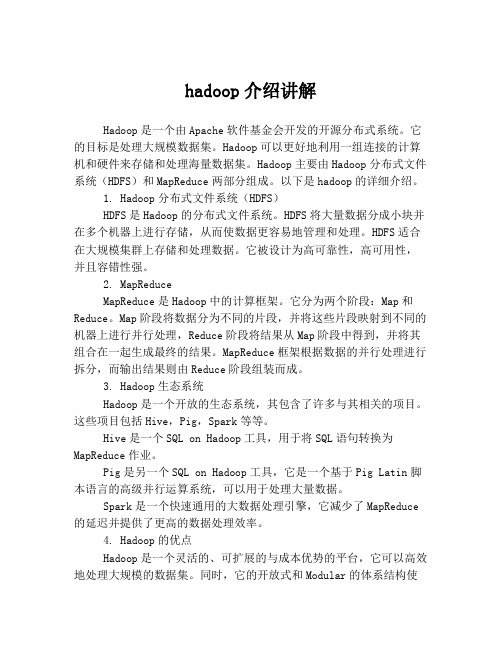
hadoop介绍讲解Hadoop是一个由Apache软件基金会开发的开源分布式系统。
它的目标是处理大规模数据集。
Hadoop可以更好地利用一组连接的计算机和硬件来存储和处理海量数据集。
Hadoop主要由Hadoop分布式文件系统(HDFS)和MapReduce两部分组成。
以下是hadoop的详细介绍。
1. Hadoop分布式文件系统(HDFS)HDFS是Hadoop的分布式文件系统。
HDFS将大量数据分成小块并在多个机器上进行存储,从而使数据更容易地管理和处理。
HDFS适合在大规模集群上存储和处理数据。
它被设计为高可靠性,高可用性,并且容错性强。
2. MapReduceMapReduce是Hadoop中的计算框架。
它分为两个阶段:Map和Reduce。
Map阶段将数据分为不同的片段,并将这些片段映射到不同的机器上进行并行处理,Reduce阶段将结果从Map阶段中得到,并将其组合在一起生成最终的结果。
MapReduce框架根据数据的并行处理进行拆分,而输出结果则由Reduce阶段组装而成。
3. Hadoop生态系统Hadoop是一个开放的生态系统,其包含了许多与其相关的项目。
这些项目包括Hive,Pig,Spark等等。
Hive是一个SQL on Hadoop工具,用于将SQL语句转换为MapReduce作业。
Pig是另一个SQL on Hadoop工具,它是一个基于Pig Latin脚本语言的高级并行运算系统,可以用于处理大量数据。
Spark是一个快速通用的大数据处理引擎,它减少了MapReduce 的延迟并提供了更高的数据处理效率。
4. Hadoop的优点Hadoop是一个灵活的、可扩展的与成本优势的平台,它可以高效地处理大规模的数据集。
同时,它的开放式和Modular的体系结构使得其在大数据环境下无论是对数据的处理还是与其他开发者的协作都非常便利。
5. 总结Hadoop是一个很好的大数据处理工具,并且在行业中得到了广泛的应用。
请简述hadoop的体系结构和主要组件。

请简述hadoop的体系结构和主要组件。
Hadoop是一个分布式计算框架,旨在帮助开发者构建大规模数据处理系统。
Hadoop的体系结构和主要组件包括:1. Hadoop HDFS:Hadoop的核心文件系统,用于存储和管理数据。
HDFS采用块存储,每个块具有固定的大小,支持数据的分片和分布式访问。
2. Hadoop MapReduce:Hadoop的主要计算引擎,将数据处理任务分解为小块并分配给多个计算节点进行并行处理。
MapReduce算法可以处理大规模数据,并实现高效的数据处理。
3. Mapper:Mapper是MapReduce中的一个核心组件,负责将输入数据映射到输出数据。
Mapper通常使用特定的语言处理数据,并将其转换为机器可以理解的形式。
4.Reducer:Reducer是MapReduce的另一个核心组件,负责将输出数据分解为较小的子数据,以便Mapper进行进一步处理。
5. Hive:Hive是一种查询引擎,允许用户在HDFS上执行离线查询。
Hive支持多种查询语言,并支持并行查询。
6. HBase:HBase是一种分布式数据库,用于存储大规模数据。
HBase采用B 树结构来存储数据,并支持高效的查询和排序。
7. Kafka:Kafka是一种分布式流处理引擎,用于处理大规模数据流。
Kafka 支持实时数据处理,并可用于数据共享、实时分析和监控等应用。
8. YARN:YARN是Hadoop的生态系统中的一个子系统,用于支持分布式计算和资源管理。
YARN与HDFS一起工作,支持应用程序在Hadoop集群中的部署和管理。
Hadoop的体系结构和主要组件提供了一种处理大规模数据的有效方法。
随着数据量的不断增加和数据处理需求的不断提高,Hadoop将继续发挥着重要的作用。
分布式文件系统设计简述

分布式文件系统设计简述分布式文件系统设计简述一、引言分布式文件系统是为了解决大规模数据存储和访问的问题而设计的一种系统。
它通过将数据分散存储在多个节点上,提供高可靠性、高性能和可扩展性。
本文将对分布式文件系统的设计进行简要介绍。
二、分布式文件系统的基本原理1. 数据划分与复制分布式文件系统将大文件划分为多个块,并在不同节点上进行复制。
这样可以提高数据的可靠性和访问速度。
2. 元数据管理元数据是指描述文件属性和位置等信息的数据。
分布式文件系统使用集中式或分布式的元数据管理方式,确保文件的一致性和可靠性。
3. 数据访问与传输分布式文件系统支持并发读写操作,并通过网络传输数据。
它通常采用副本选择策略来选择最近或最快的节点进行数据访问。
三、常见分布式文件系统设计方案1. Google 文件系统(GFS)GFS 是 Google 公司开发的一种分布式文件系统,它采用了大块存储、冗余复制和集中管理等技术。
GFS 能够处理 PB 级别的数据,并具有高可用性和容错能力。
2. Hadoop 分布式文件系统(HDFS)HDFS 是 Apache Hadoop 生态系统中的一种分布式文件系统,它采用了类似GFS 的设计思想。
HDFS 适用于大规模数据处理和分析,具有高吞吐量和容错性。
3. Ceph 文件系统Ceph 是一种分布式对象存储和文件系统,它具有高可靠性、可扩展性和自修复能力。
Ceph 文件系统支持多种访问接口,并提供了强大的数据保护机制。
四、分布式文件系统的设计考虑因素1. 可靠性与容错性分布式文件系统需要具备高可靠性和容错能力,能够自动检测和修复节点故障,并保证数据的完整性。
2. 性能与扩展性分布式文件系统需要具备高吞吐量和低延迟的特点,能够支持大规模数据访问和处理,并能够方便地扩展节点数量。
3. 数据一致性与并发控制分布式文件系统需要保证多个节点之间的数据一致性,并提供有效的并发控制机制,避免数据冲突和竞争条件。
hadoop工作原理

hadoop工作原理Hadoop工作原理Hadoop是一个开源的分布式计算框架,被广泛应用于大数据处理和分析。
它的工作原理是基于分布式存储和计算的概念,能够高效地处理大规模数据集。
Hadoop的工作原理可以简单地分为两个主要部分:Hadoop分布式文件系统(Hadoop Distributed File System,简称HDFS)和Hadoop分布式计算框架(Hadoop MapReduce)。
让我们来了解HDFS。
HDFS是Hadoop的分布式文件系统,它被设计用于在大规模集群上存储和处理数据。
HDFS将大文件切分成多个数据块,然后将这些数据块分散存储在集群中的不同节点上。
每个数据块都有多个副本,这样可以提高数据的可靠性和容错性。
HDFS采用了主从架构,其中有一个主节点(NameNode)负责管理文件系统的命名空间和访问控制,以及多个从节点(DataNode)负责存储和处理数据。
当客户端需要读取或写入文件时,它会首先与主节点通信,获取文件的位置信息,然后直接与数据节点进行交互。
接下来,我们来看Hadoop MapReduce的工作原理。
MapReduce是一种编程模型,用于处理大规模数据集的并行计算。
它将计算任务分为两个阶段:Map阶段和Reduce阶段。
在Map阶段,输入数据被切分成多个独立的片段,然后由多个Map任务并行处理。
每个Map任务将输入数据转化为键值对,并生成中间结果。
在Reduce阶段,中间结果按照键进行分组,然后由多个Reduce任务并行处理。
每个Reduce任务将同一键的中间结果合并,并生成最终的计算结果。
Hadoop的工作原理可以总结为以下几个步骤:1. 客户端向HDFS发送文件读取或写入请求。
2. 主节点(NameNode)接收请求,并返回文件的位置信息。
3. 客户端直接与数据节点(DataNode)进行数据交互,实现文件的读取或写入操作。
4. 当需要进行大规模计算时,客户端编写MapReduce程序,并提交给Hadoop集群。
- 1、下载文档前请自行甄别文档内容的完整性,平台不提供额外的编辑、内容补充、找答案等附加服务。
- 2、"仅部分预览"的文档,不可在线预览部分如存在完整性等问题,可反馈申请退款(可完整预览的文档不适用该条件!)。
- 3、如文档侵犯您的权益,请联系客服反馈,我们会尽快为您处理(人工客服工作时间:9:00-18:30)。
Hadoop分布式文件系统:架构和设计引言 (2)一前提和设计目标 (2)1 hadoop和云计算的关系 (2)2 流式数据访问 (2)3 大规模数据集 (2)4 简单的一致性模型 (3)5 异构软硬件平台间的可移植性 (3)6 硬件错误 (3)二HDFS重要名词解释 (3)1 Namenode (4)2 secondary Namenode (5)3 Datanode (6)4 jobTracker (6)5 TaskTracker (6)三HDFS数据存储 (7)1 HDFS数据存储特点 (7)2 心跳机制 (7)3 副本存放 (7)4 副本选择 (7)5 安全模式 (8)四HDFS数据健壮性 (8)1 磁盘数据错误,心跳检测和重新复制 (8)2 集群均衡 (8)3 数据完整性 (8)4 元数据磁盘错误 (8)5 快照 (9)引言云计算(cloud computing),由位于网络上的一组服务器把其计算、存储、数据等资源以服务的形式提供给请求者以完成信息处理任务的方法和过程。
在此过程中被服务者只是提供需求并获取服务结果,对于需求被服务的过程并不知情。
同时服务者以最优利用的方式动态地把资源分配给众多的服务请求者,以求达到最大效益。
Hadoop分布式文件系统(HDFS)被设计成适合运行在通用硬件(commodity hardware)上的分布式文件系统。
它和现有的分布式文件系统有很多共同点。
但同时,它和其他的分布式文件系统的区别也是很明显的。
HDFS是一个高度容错性的系统,适合部署在廉价的机器上。
HDFS 能提供高吞吐量的数据访问,非常适合大规模数据集上的应用。
一前提和设计目标1 hadoop和云计算的关系云计算由位于网络上的一组服务器把其计算、存储、数据等资源以服务的形式提供给请求者以完成信息处理任务的方法和过程。
针对海量文本数据处理,为实现快速文本处理响应,缩短海量数据为辅助决策提供服务的时间,基于Hadoop云计算平台,建立HDFS分布式文件系统存储海量文本数据集,通过文本词频利用MapReduce原理建立分布式索引,以分布式数据库HBase 存储关键词索引,并提供实时检索,实现对海量文本数据的分布式并行处理.实验结果表明,Hadoop框架为大规模数据的分布式并行处理提供了很好的解决方案。
2 流式数据访问运行在HDFS上的应用和普通的应用不同,需要流式访问它们的数据集。
HDFS的设计中更多的考虑到了数据批处理,而不是用户交互处理。
比之数据访问的低延迟问题,更关键的在于数据访问的高吞吐量。
3 大规模数据集运行在HDFS上的应用具有很大的数据集。
HDFS上的一个典型文件大小一般都在G字节至T字节。
因此,HDFS被调节以支持大文件存储。
它应该能提供整体上高的数据传输带宽,能在一个集群里扩展到数百个节点。
一个单一的HDFS实例应该能支撑数以千万计的文件。
4 简单的一致性模型HDFS应用需要一个“一次写入多次读取”的文件访问模型。
一个文件经过创建、写入和关闭之后就不需要改变。
这一假设简化了数据一致性问题,并且使高吞吐量的数据访问成为可能。
Map/Reduce应用或者网络爬虫应用都非常适合这个模型。
目前还有计划在将来扩充这个模型,使之支持文件的附加写操作。
5 异构软硬件平台间的可移植性HDFS在设计的时候就考虑到平台的可移植性。
这种特性方便了HDFS作为大规模数据应用平台的推广。
6 硬件错误硬件错误是常态而不是异常。
HDFS可能由成百上千的服务器所构成,每个服务器上存储着文件系统的部分数据。
我们面对的现实是构成系统的组件数目是巨大的,而且任一组件都有可能失效,这意味着总是有一部分HDFS的组件是不工作的。
因此错误检测和快速、自动的恢复是HDFS最核心的架构目标。
二HDFS重要名词解释HDFS采用master/slave架构。
一个HDFS集群是由一个Namenode和一定数目的Datanodes组成。
Namenode是一个中心服务器,负责管理文件系统的名字空间(namespace)以及客户端对文件的访问。
集群中的Datanode一般是一个节点一个,负责管理它所在节点上的存储。
HDFS暴露了文件系统的名字空间,用户能够以文件的形式在上面存储数据。
从内部看,一个文件其实被分成一个或多个数据块,这些块存储在一组Datanode上。
Namenode执行文件系统的名字空间操作,比如打开、关闭、重命名文件或目录。
它也负责确定数据块到具体Datanode节点的映射。
Datanode负责处理文件系统客户端的读写请求。
在Namenode的统一调度下进行数据块的创建、删除和复制。
集群中单一Namenode的结构大大简化了系统的架构。
Namenode是所有HDFS元数据的仲裁者和管理者,这样,用户数据永远不会流过Namenode。
1 Namenode(1)HDFS的守护程序。
(2)记录文件时如何分割成数据块的,以及这些数据块被存数到那些借点上。
(3)对内存和I/O进行集中管理(4)namenode是单个节点,发生故障将使集群崩溃。
2 secondary Namenode(1)监控HDFS状态的辅助后台程序(2)secondary Namenode与namenode通讯,定期保存HDFS元数据快照。
(3)当namenode故障时候,secondary Namenode可以作为备用namenode使用。
3 DatanodeDatanode将HDFS数据以文件的形式存储在本地的文件系统中,它并不知道有关HDFS文件的信息。
它把每个HDFS数据块存储在本地文件系统的一个单独的文件中。
Datanode并不在同一个目录创建所有的文件,实际上,它用试探的方法来确定每个目录的最佳文件数目,并且在适当的时候创建子目录。
4 jobTracker(1)用于处理作业的后台程序(2)决定有哪些文件参与处理,然后切割task并分配节点(3)监控task,重启失败的task(4)每个集群只有唯一一个jobTracker,位于Master。
5 TaskTracker(1)位于slave节点上,与datanode结合(2)管理各自节点上的task(由jobTracker分配)(3)每个节点只有一个tasktracker,但一个tasktracker可以启动多个JVM,(4)与jobtracker交互三HDFS数据存储1 HDFS数据存储特点(1)HDFS被设计成能够在一个大集群中跨机器可靠地存储超大文件。
(2)它将每个文件存储成一系列的数据块,除了最后一个,所有的数据块都是同样大小的,数据块的大小是可以配置的。
(3)文件的所有数据块都会有副本。
每个副本系数都是可配置的。
(4)应用程序可以指定某个文件的副本数目。
(5)HDFS中的文件都是一次性写入的,并且严格要求在任何时候只能有一个写入者。
2 心跳机制Namenode全权管理数据块的复制,它周期性地从集群中的每个Datanode接收心跳信号和块状态报告(Blockreport)。
接收到心跳信号意味着该Datanode节点工作正常。
块状态报告包含了一个该Datanode上所有数据块的列表。
3 副本存放副本的存放是HDFS可靠性和性能的关键。
HDFS采用一种称为机架感知(rack-aware)的策略来改进数据的可靠性、可用性和网络带宽的利用率。
4 副本选择为了降低整体的带宽消耗和读取延时,HDFS会尽量让读取程序读取离它最近的副本。
如果在读取程序的同一个机架上有一个副本,那么就读取该副本。
如果一个HDFS集群跨越多个数据中心,那么客户端也将首先读本地数据中心的副本。
5 安全模式Namenode启动后会进入一个称为安全模式的特殊状态。
处于安全模式的Namenode是不会进行数据块的复制的。
Namenode从所有的Datanode接收心跳信号和块状态报告。
四HDFS数据健壮性HDFS的主要目标就是即使在出错的情况下也要保证数据存储的可靠性。
常见的三种出错情况是:Namenode出错, Datanode出错和网络割裂(network partitions)。
1 磁盘数据错误,心跳检测和重新复制每个Datanode节点周期性地向Namenode发送心跳信号。
网络割裂可能导致一部分Datanode跟Namenode失去联系。
Namenode通过心跳信号的缺失来检测这一情况,并将这些近期不再发送心跳信号Datanode标记为宕机,不会再将新的IO请求发给它们。
任何存储在宕机Datanode上的数据将不再有效。
Datanode的宕机可能会引起一些数据块的副本系数低于指定值,Namenode不断地检测这些需要复制的数据块,一旦发现就启动复制操作。
在下列情况下,可能需要重新复制:某个Datanode节点失效,某个副本遭到损坏,Datanode 上的硬盘错误,或者文件的副本系数增大。
2 集群均衡HDFS的架构支持数据均衡策略。
如果某个Datanode节点上的空闲空间低于特定的临界点,按照均衡策略系统就会自动地将数据从这个Datanode移动到其他空闲的Datanode。
当对某个文件的请求突然增加,那么也可能启动一个计划创建该文件新的副本,并且同时重新平衡集群中的其他数据。
这些均衡策略目前还没有实现。
3 数据完整性从某个Datanode获取的数据块有可能是损坏的,损坏可能是由Datanode的存储设备错误、网络错误或者软件bug造成的。
HDFS客户端软件实现了对HDFS文件内容的校验和(checksum)检查。
当客户端创建一个新的HDFS文件,会计算这个文件每个数据块的校验和,并将校验和作为一个单独的隐藏文件保存在同一个HDFS名字空间下。
当客户端获取文件内容后,它会检验从Datanode获取的数据跟相应的校验和文件中的校验和是否匹配,如果不匹配,客户端可以选择从其他Datanode获取该数据块的副本。
4 元数据磁盘错误FsImage和Editlog是HDFS的核心数据结构。
如果这些文件损坏了,整个HDFS实例都将失效。
因而,Namenode可以配置成支持维护多个FsImage和Editlog的副本。
任何对FsImage或者Editlog的修改,都将同步到它们的副本上。
这种多副本的同步操作可能会降低Namenode每秒处理的名字空间事务数量。
然而这个代价是可以接受的,因为即使HDFS的应用是数据密集的,它们也非元数据密集的。
当Namenode重启的时候,它会选取最近的完整的FsImage和Editlog来使用。
Namenode是HDFS集群中的单点故障(single point of failure)所在。
如果Namenode机器故障,是需要手工干预的。
目前,自动重启或在另一台机器上做Namenode故障转移的功能还没实现。
